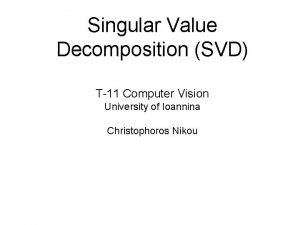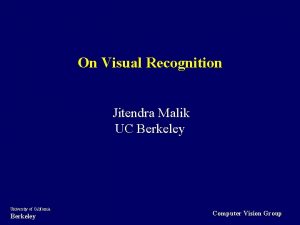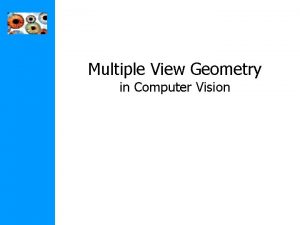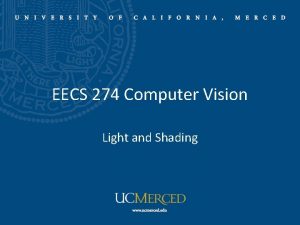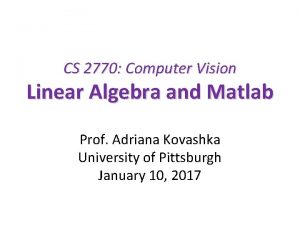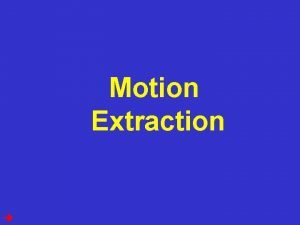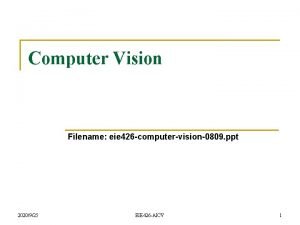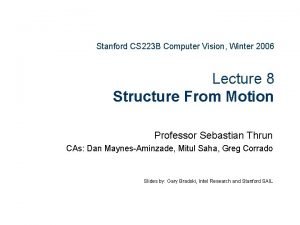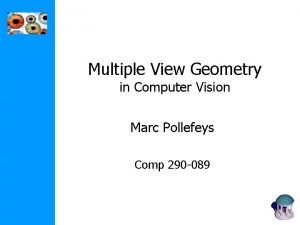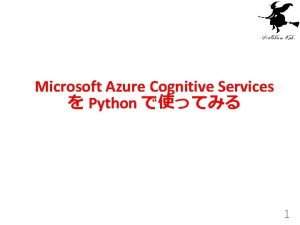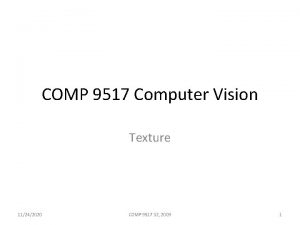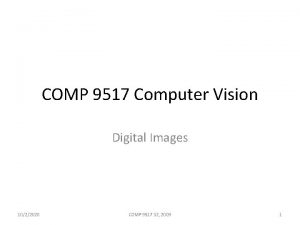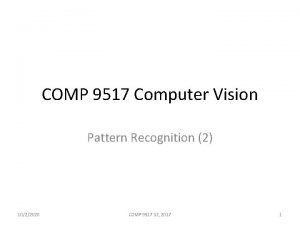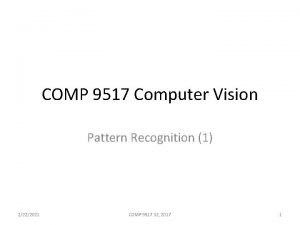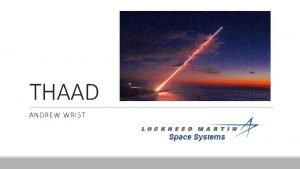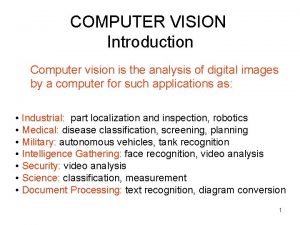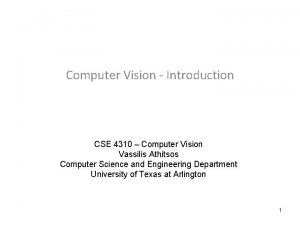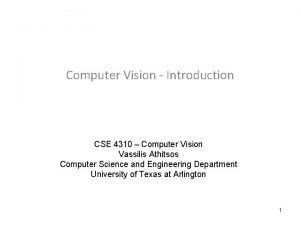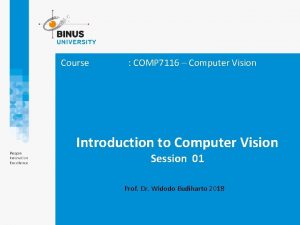COMP 9517 Computer Vision Introduction 1212020 COMP 9517















- Slides: 15

COMP 9517 Computer Vision Introduction 12/1/2020 COMP 9517 S 2, 2009 1

Computer Vision • Computer vision has been around since 1960’s, but it only recently became possible to build useful vision system. • Computer and imaging system have become much cheaper. • Our understanding of basic geometry and physics underlying vision has been improved significantly. • It is a great time to be studying computer vision. 12/1/2020 COMP 9517 S 2, 2009 2

What is Computer Vision? • What are the goals of computer vision? • What are the applications? • What are computer vision processes? 12/1/2020 COMP 9517 S 2, 2009 3

Goals of Computer Vision • Make useful decisions about real physical objects and scenes based on sensed images or sequences of images. • Alternative: goal is the construction of scene descriptions from images. • Use statistical methods to process data using models constructed with the aid of geometry, physics and learning theory. 12/1/2020 COMP 9517 S 2, 2009 4

Computer Vision Topics • Requires a solid understanding of camera and of the physical process of image, • to obtain simple inferences from individual pixel values, • to combine the information available in multiple images into a coherent whole, • to enforce some order on groups of pixels to separate them from each other or infer shape information, • to recognise objects using geometric information or probabilistic techniques. 12/1/2020 COMP 9517 S 2, 2009 5

Critical Issues • Sensing: how do sensors obtain images of the world? • Encoded Information: how do image yield information of the scene, such as color, texture, shape, motion, etc. ? • Representations: what representations are appropriate to describe objects? • Algorithms: what algorithms process image information and construct scene descriptions? 12/1/2020 COMP 9517 S 2, 2009 6

CV Applications • Vision-based HCI – Eye. Mouse: a vision-based eye control system – To use human head and eyes to control computers, so how? – Computer vision and an webcam to track the eyes and head – Shakes and winks to control a mouse pointer on the screen – Face expression recognition – Challenge: clutter and real time • Game Controller: Cam-Trax 12/1/2020 COMP 9517 S 2, 2009 7

CV Applications • Geographical: GIS – Interpreting satellite images – Road detection for creating maps – Edge detection, Road edge classification and linking – Challenge: complex and wide scene, occlusion, low resolution or large data size. 12/1/2020 COMP 9517 S 2, 2009 8

CV Applications • Medical Imaging – Enhance imagery, or identify important phenomena or events, or visualise information obtained by imaging – Parenchymal bands: linear structures touching the lung boundary – Segment and classify candidate regions into positive (parenchymal bands) and negative (others) class – Challenge: • Often attached to other structures, in this case a nodular mass • Similar appearance to blood vessels 12/1/2020 COMP 9517 S 2, 2009 9

CV Applications • Video Surveillance – Traffic Monitoring – Object tracking – Action recognition, driving, stopping, etc – Vehicle speed – Counting – Challenge: occlusion, illumination changes and non-linear speed 12/1/2020 COMP 9517 S 2, 2009 10

CV Applications • Image/video retrieval – Content-based retrieval – Search engine – Challenge: big data volume, semantic 12/1/2020 COMP 9517 S 2, 2009 11

CV Applications • Text Recognition – Converting information from paper documents into digital form – Challenge: semantic interpretation I looked as hard as I could see, beyond 100 plus infinity an object of bright intensity- it was the back of me! 12/1/2020 COMP 9517 S 2, 2009 12

Computer Vision Processes • Low level processes – use little knowledge of image content – include image compression, noise filtering, edge extraction, . . . – use data which resemble the input image, eg. matrix of picture elements • High level processes – based on knowledge, goals, plans – use Artificial Intelligence methods – simulate human cognition and decision making based on information in the image – cognitive processes, geometric models, goals, plans, . . . 12/1/2020 COMP 9517 S 2, 2009 13

Low Level Vision • almost entirely digital image processing – sensing: image capture and digitisation – pre-processing: improve image quality: suppress noise, enhance object features, edge extraction – image segmentation: separate objects from background, partition image into objects of interest – description: compute features which differentiate objectsalso called feature extraction – Classification: assign labels to image segments (regions) 12/1/2020 COMP 9517 S 2, 2009 14

High Level Vision • About knowledge construction, representation and inference – recognition: identification of objects – interpretation: assign meaning to groups of recognized objects – scene analysis 12/1/2020 COMP 9517 S 2, 2009 15
 Cs766
Cs766 16385 cmu
16385 cmu Kalman filter computer vision
Kalman filter computer vision T11 computer
T11 computer Berkeley computer vision
Berkeley computer vision Multiple view geometry in computer vision pdf
Multiple view geometry in computer vision pdf Computer vision vs image processing
Computer vision vs image processing Radiometry in computer vision
Radiometry in computer vision Linear algebra for computer vision
Linear algebra for computer vision Computer vision
Computer vision Computer vision
Computer vision Watershed segmentation
Watershed segmentation Computer vision stanford
Computer vision stanford Quadrifocal
Quadrifocal Python cognitive services
Python cognitive services Mathematical foundations of computer graphics and vision
Mathematical foundations of computer graphics and vision



